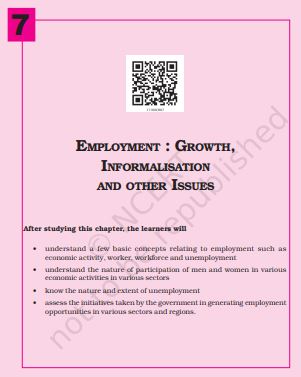‘NCERT Solutions for Class 11 Economics Chapter 7 Employment Growth, Informalisation and Other Issues‘ PDF Quick download link is given at the bottom of this article. You can see the PDF demo, size of the PDF, page numbers, and direct download Free PDF of ‘Ncert Class 11 Economics Chapter 7 Exercise Solution’ using the download button.
Employment Growth, Informalisation and Other Issues NCERT Textbook With Solutions Book PDF Free Download

Chapter 7: Employment Growth, Informalisation and Other Issues
People do a variety of work. Some work on farms, in factories, banks, shops and many other workplaces; yet a few others work at home.
Work at home includes not only traditional work like weaving, lace making or variety of handicrafts but also modern jobs like programming work in the IT industry.
Earlier factory work meant working in factories located in cities whereas now technology has enabled people to produce those factory-based goods at home in villages.
During Covid 19 pandemic in 2020-21, millions of workers delivered their products and services through work from home.
Why do people work? Work plays an important role in our lives as individuals and as members of society. People work for ‘earning’ a living. Some people get, or have, money by inheriting it, not working for it. This does not completely satisfy anybody.
Being employed in work gives us a sense of self-worth and enables us to relate ourselves meaningfully with others.
Every working person is actively contributing to national income and hence, the development of the country by engaging in various economic activities — that is the real meaning of ‘earning’ a living.
We do not work only for ourselves; we also have a sense of accomplishment when we work to meet the requirements of those who are dependent on us.
Having recognized the importance of work, Mahatma Gandhi insisted upon education and training through a variety of works including craft.
Studying about working people gives us insights into the quality and nature of employment in a country and helps in understanding and planning our human resources.
It helps us to analyse the contribution made by different industries and sectors towards national income. It also helps us to address many social issues such as exploitation of marginalized sections of society, child labor, etc.
7.2 Workers And Employment
What is employment? Who is a worker? When a farmer works on fields, he or she produces food grains and raw materials for industries. Cotton becomes cloth in textile mills and in power looms. Lorries transport goods from one place to another.
We know that the total money value of all such final goods and services produced in a country in a year is called its gross domestic product for that year.
When we also consider what we pay for our imports and get from our exports we find that there is a net earning for the country which may be positive (if we have exported more in value terms than imported) or negative (if imports exceeded exports in value terms) or zero (if exports and imports were of the same value).
When we add this earning (plus or minus) from foreign transactions, what we get is called the country’s gross national product for that year.
Those activities which contribute to the gross national product are called economic activities.
All those who are engaged in economic activities, in whatever capacity — high or low, are workers.
Even if some of them temporarily abstain from work due to illness, injury or other physical disability, bad weather, festivals, social or religious functions, they are also workers.
Workers also include all those who help the main workers in these activities. We generally think of only those who are paid by an employer for their work as workers. This is not so. Those who are self-employed are also workers.
| Author | NCERT |
| Language | English |
| No. of Pages | 23 |
| PDF Size | 3.3 MB |
| Category | Economics |
| Source/Credits | ncert.nic.in |
NCERT Solutions Class 11 Economics Chapter 7 Employment Growth, Informalisation, and Other Issues
1. Who is a worker?
A worker is defined as a person who is involved in production activity and is actively contributing towards the flow of goods and services in the economy.
2. Define the worker-population ratio.
It is defined as that part of the population that is providing active service in the production of goods and services. For calculating worker population ratio we have to divide the total work force by the total population and multiplying by 100. It is an indicator that helps in assessing the level of employment in a country at any point in time. It can be denoted in formulae as:

3. Are the following workers — a beggar, a thief, a smuggler, a gambler? Why?
None of them can be called as workers as they are not involved in any such activity that contributes to GDP of the country.
4. Find the odd man out (i) owner of a saloon (ii) a cobbler (iii) a cashier in Mother Dairy (iv) a tuition master (v) transport operator (vi) construction worker.
Cashier in mother diary is the odd one as he is salaried.
5. The newly emerging jobs are found mostly in the ____________sector.
(Service/manufacturing).
Service
6. An establishment with four hired workers is known as __________ (formal/informal) sector establishment.
Informal
7. Raj is going to school. When he is not in school, you will find him working in his farm. Can you consider him as a worker? Why?
Yes, because he is contributing towards the total output of the farm and as per definition of a worker, Raj can be considered as a worker.
Related PDFs
अर्थशास्त्र वस्तुनिष्ठ प्रश्न और उत्तर PDF In Hindi
NCERT Class 11 Economics Textbook Chapter 7 With Answer PDF Free Download
